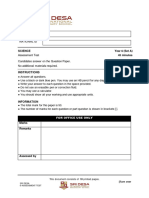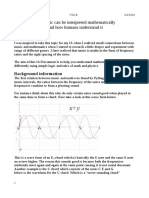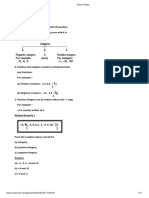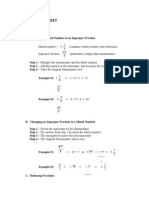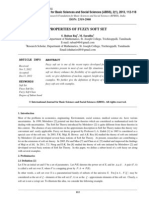Fraction Notes
Fraction Notes
Uploaded by
api-272836036Copyright:
Available Formats
Fraction Notes
Fraction Notes
Uploaded by
api-272836036Original Title
Copyright
Available Formats
Share this document
Did you find this document useful?
Is this content inappropriate?
Copyright:
Available Formats
Fraction Notes
Fraction Notes
Uploaded by
api-272836036Copyright:
Available Formats
5th Grade Math Notes
Basic Fraction
Mixed Numbers and Improper Fractions
When converting a mixed number into an improper
numerator
denominator
- (the # of pieces shaded or unshaded)
fraction you multiply the denominator by the whole
number, then add the numerator.
- (the total number of pieces)
Example:
Example:
5
12
12 x 3 + 5 = 41
12
**Hint: The denominator does NOT change.**
When converting an improper fraction into a mixed
number you divide the numerator by the denominator.
**Hint: Zero can NEVER be a denominator.**
3 R5
41
12
12
41
- 36
12
**Hint: The dividend becomes the whole number
and the remainder becomes the numerator and
your denominator does NOT change.**
Equivalent Fraction
Adding Fractions
~ For the numerators add straight across.
~ The denominator does not change.
Ex.
12
24
The rule when converting fractions is that what ever
you do to the top you must also do to the bottom.
12
24
3
6
~ You divided 24 by 6 which equals 4.
~ Since you divided 24 by 6, you also have to divide
12 by 6.
~ 12 divided by 6 equals 2
=
5
6
Ex.
1
4
have to determine which operation was used.
24
2
6
~ If your denominator is 24 and it changes to 4 you
12
2
4
3
4
* Hint: Make sure you have a common
denominator before you add.
5th Grade Math Notes
Multiplying Fractions
Adding & Subtracting with UNLIKE Denominators
1
2
~ Multiply the numerator by the numerator.
~ Multiply the denominator by the denominator.
1. Find the least common multiple (LCM) by listing the
Ex.
multiples of each denominator in the problem. Circle
3
4
the least common multiple and use it as your common
6
24
denominator. (Ex: the LCM of 2 and 3 is 6. Use 6 as
your common denominator.)
2: 2, 4, 6,
3: 3, 6
2. Rename the fractions using the new common
denominator.
1
2
4
6
3. Perform the operation & keep the new denominator.
3
6
4
6
*HINT: remember to simplify your answer.
Ex.
4. Write the answer in simplest form.
7
6
24
Dividing Fractions
Sled Method
~ Invert the fraction
~ The method will help you find the simplest form of a fraction
~ multiply the fractions
AND the GCF and LCM for the numerator and denominator.
12
1
3
4
1
2
4
3
18
12
18
~ Draw a sled and write the fraction in it.
~ Divide by the lowest prime number.
~ Continue dividing by the lowest prime number
until the numbers under the sled cannot be
4
6
divided by any number other than 1
~ The two numbers under the last sled shows the
fraction in simplest form.
~ Draw a picture to represent the first fraction and draw a ~ To find the GCF multiply the numbers to the
picture beneath that to represent the second fraction.
left of the sled. (ex. 2 x 3 = 6) GCF = 6
~ Draw a line where the second fraction ends and that ~ To find the LCM multiply the numbers to the
fraction has a new denominator.
left
~ See how many squares on the bottom picture match the
(ex. 2 x 3 x 2 x 3 = 36)
top picture and that is the new fraction.
of
the
sled
and
below
LCM = 36
the
sled
5th Grade Math Notes
Operations With Decimals
Measurement Conversions
12 inches = 1 foot
Adding Decimals:
1. Line up the decimal points and add as usual.
3 feet = 1 yard
1,760 yard = 1 mile
2. Drag the decimal straight down.
distance
5,280 feet = 1 mile
Subtracting Decimals:
1. Line up the decimal points and subtract as usual.
1 kilometer = 1,000 meters
2. Drag the decimal point straight down.
Multiplying Decimals:
1. Multiply as usual.
1 gallon = 4 quarts
2. Count the digits behind the decimals.
1 quart = 2 pints
3. Place your decimal point in the product (answer).
1 pint = 2 cups
Make sure the product and the original problem have
1 cup = 8 ounces
capacity
the same number of digits behind the decimal.
Dividing Decimals:
1. Move the decimal in the divisor so it is a whole
number. Move the decimal in the dividend the same
number of spaces.
3. Divide as usual.
16 oz. = 1 lb.
1
8 oz. =
lb.
2
1
4 oz. =
lb.
4
weight
4. In your answer, place the decimal directly above
the decimal in the dividend.
Fraction, Decimal and Percent
3
4
0.75
75%
~ To find the decimal divide the numerator by the
denominator.
3
4
0.
3.
7
0
5
0
decimal =
0.75
0
3
-2
8
2
-2
Rounding Rap
~ The percentage is the first two numbers behind
the decimal point. (decimal 0.75 = 75%)
~ To determine a fraction from a decimal put the
decimal in fraction form and simplify.
Ex.
75
3
0.75
=
=
100
4
Yo, find that place value
Circle that digit
Move to the right, underline get it.
0-4 circle stays the same
5-9 add one is the game
Now flex your muscles like a hero
Digits to the right change to zero
All the other digits stay the same
Yo! Youre the winner of the rounding
game!
5th Grade Math Notes
Divisibility Rules 2-5
tens
hundreds
ones
If the last digit is divisible
by 2 then the original
number is divisible by 2.
thousands
ten thousands
hundred thousands
millions
ten millions
hundred millions
Place Value
If the sum of the digits is
divisible by three then the
original number is divisible
by 3.
thousandths
hundredths
tenths
ones
tens
hundreds
If the last two digits are
divisible by four then the
original number is divisible
by 4.
thousands
ten thousands
hundred thousands
Whole Numbers
If the last digit is a five or a
zero then the number is
divisible by 5.
Whole
Long Division
Bring down
Example: 495
4+9+5 = 18
(Since 18 is divisible by 3 then
495 is divisible by 3.)
Example: 4,328
(Since 28 is divisible by four
then 4,328 is divisible by 4.)
Example: 3,695
(Since the last digit is a 5 then
3,695 is divisible by 5.)
Divisibility Rules 6-10
1 2 3 7 R 1
Multiply
Subtract
(Since 8 is divisible by two
then 4,368 is divisible by 2.)
Parts of a
Whole Numbers
Divide
Example: 4,368
6 7 4 2 3
-6
1 4
Example: 534
If the number is divisible by
two and three then the
number is divisible by 6.
-1 2
0 2 2
-1 8
0 4 3
-4 2
0 1
If the last three digits are
divisible by eight then the
original number is divisible
by 8.
Is it divisible by 2? yes
because 4 is divisible by 2
Is it divisible by 3? yes
because 5+3+4=12 and 12 is
divisible by 3
so 534 is divisible by 6
Example 7,328
(Since 328 is divisible by eight
then 7,328 is divisible by 8.)
~ Divide 6 into 7 one time so 1 goes above the 7.
~ Multiply 1 by 6 which equals 6 and subtract
from 7 which equals 1.
~ Then bring down the 4 and the process begins
again until every number has been divided.
~ The final answer is 1,237 remainder 1.
If the sum of the digits is
divisible by nine then the
original number is divisible
by 9.
If the last digit is a zero then
**Hint: If you have to bring a number down then the number is divisible by
10.
you start back over with divide.
Example: 495
4+9+5 = 18
(Since 18 is divisible by 9 then
495 is divisible by 9.)
Example: 4,560
(Since the last digit is a 0 then
4,560 is divisible by 10.)
5th Grade Math Notes
Geometry Formulas
triangle:
P=s+s+s
1
2
A=
A=
A=
bh
1
2
P = 6"+6"+6" = 18"
6"(5") = 15 in.2
Geometry Formulas
P = perimeter (The distance around a figure.)
A = area (The measure, in square units, of the
inside of a plane figure.)
V = volume (The number of cubic units a space of
bxh
a solid figure takes up.)
quadrilateral:
P = 7" + 7" = 5" + 5" =24"
P=s+s+s+s
A = 6 x 7 = 42 in.2
6 in.
6 in.
A = bh
2 ft.
10 ft.
6 in.
P = 6" + 4" + 6" + 4" = 20"
A = 4 x 6= 24 in.2
V=lxwxh
circle:
C = 2r
A = r
( 3.14)
V=6x6x6
V = 216 in.3
C = 2r
C = 2()(3")
C = 6
2 ft.
A = r2
V=lxwxh
A = (32)
A = 9
C = 18.84"
A = 28.26 in.
Mean, Median, Mode and Range
V = 2 x 2 x 10
2
Data: 23, 27, 25, 22, 29, 23, 26
Mean (average):
~ Add the numbers together
~ Count up how many numbers you added together
Data Analysis
V = 40 ft.3
Line Graph
Shows changes over
Circle Graph
Shows data that is
time
part of a whole
Double-Bar Graph
Line Plot
Shows frequency of
Compares similar Data
data along a number
and divide the sum by that number.
Ex. 23+27+25+22+29+23+26 = 175
175 7 = 25
Mean = 25
Median:
~ Put the numbers in numerical order and the
number in the middle is the median.
22, 23, 23, 25, 26, 27, 29
Median = 25
Mode:
~ The number that occurs most often.
Mode: 23
Range:
~ The largest number subtract the lowest number.
Ex.
29 - 22 = 7
Range = 7
You might also like
- Divisibility Rule: Divisibility Rules For Numbers 1-20Document16 pagesDivisibility Rule: Divisibility Rules For Numbers 1-20themathlover50% (2)
- Sci - Y6 (Set A) - Assesment Test - 2023Document10 pagesSci - Y6 (Set A) - Assesment Test - 2023JK EduNotesNo ratings yet
- Old School - Test Papers - Old School - Preliminary Examination (#7)Document18 pagesOld School - Test Papers - Old School - Preliminary Examination (#7)mangayarkarasir100% (3)
- CalcIII Complete Assignments PDFDocument58 pagesCalcIII Complete Assignments PDFEko PrayetnoNo ratings yet
- Math IA 2Document3 pagesMath IA 2Aarush Ram AnandhNo ratings yet
- Year 4 AssessmentDocument7 pagesYear 4 AssessmentSim Lu YeoNo ratings yet
- Area of A Triangle PDFDocument4 pagesArea of A Triangle PDFJames KeruNo ratings yet
- Class 4 Holiday Homework 2023-24Document14 pagesClass 4 Holiday Homework 2023-24Kiran RangineniNo ratings yet
- YEAR 5 TITLE - English Grammar and Punctuation Test 1Document4 pagesYEAR 5 TITLE - English Grammar and Punctuation Test 1Miss ShashaNo ratings yet
- Maths PlanDocument19 pagesMaths PlanmissedmondsNo ratings yet
- 3rd Grade Spelling Lists 2013Document7 pages3rd Grade Spelling Lists 2013api-242607732No ratings yet
- Geography 7 Skills ANSWERSDocument20 pagesGeography 7 Skills ANSWERSmitsupl12No ratings yet
- Year 3 EnglishDocument18 pagesYear 3 EnglishAhmad FadzilNo ratings yet
- Subtraction Lesson PlanDocument1 pageSubtraction Lesson Planapi-485205773No ratings yet
- Form 4 :setsDocument2 pagesForm 4 :setsmirete86No ratings yet
- Grade 5 Language Arts Week 1 Lesson 1Document4 pagesGrade 5 Language Arts Week 1 Lesson 1Princess RedNo ratings yet
- Volume of SolidsDocument10 pagesVolume of SolidsYusufAliBahrNo ratings yet
- Year 4 Paper 1Document6 pagesYear 4 Paper 1Angel LinaNo ratings yet
- Maths f2 Lev5to7 Main 2016Document12 pagesMaths f2 Lev5to7 Main 2016Fook Long WongNo ratings yet
- GR 7 Term 4 2017 Maths Content Booklet Targeted SupportDocument50 pagesGR 7 Term 4 2017 Maths Content Booklet Targeted SupportIrfaanNo ratings yet
- Science Around Us Book 2Document54 pagesScience Around Us Book 2Kat100% (3)
- Maths 2009 PSR p2Document11 pagesMaths 2009 PSR p2Sity ZariahNo ratings yet
- Reading Comprehension VIDocument7 pagesReading Comprehension VIViệt HùngNo ratings yet
- Year 3 English Grammar and Punctuation Test 6Document4 pagesYear 3 English Grammar and Punctuation Test 6Gehad AliNo ratings yet
- Y6 Autumn Block 1 WO8 Negative Numbers 2022Document2 pagesY6 Autumn Block 1 WO8 Negative Numbers 2022M alfyNo ratings yet
- Year 2 Position and Direction MovementDocument20 pagesYear 2 Position and Direction MovementzaeemNo ratings yet
- Pre-Test Mathematics 5Document3 pagesPre-Test Mathematics 5norvel_19100% (1)
- Exercise Regular and Irregular PolygonsDocument9 pagesExercise Regular and Irregular PolygonsAnnaPaulinaNeblinaNo ratings yet
- GR 4 Mathematics 1st 4thDocument230 pagesGR 4 Mathematics 1st 4thGolden SunriseNo ratings yet
- Simple Past TenseDocument2 pagesSimple Past TenseNik SyahNo ratings yet
- Math PT3 Revision 1 2 3Document5 pagesMath PT3 Revision 1 2 3Noor Fazliati SulaimanNo ratings yet
- Mathematics Upsr TipDocument15 pagesMathematics Upsr TipyenyingNo ratings yet
- Math DrillDocument2 pagesMath DrillfranjoyNo ratings yet
- Decimals: HapterDocument10 pagesDecimals: HaptersnehaNo ratings yet
- Maths PSRDocument14 pagesMaths PSRNazihah ShazliNo ratings yet
- Year 4 ScienceDocument3 pagesYear 4 Scienceruby1023No ratings yet
- Road To Triumph Ultimate Guide - UpdatedDocument65 pagesRoad To Triumph Ultimate Guide - UpdatedKogilavani MuniandyNo ratings yet
- 2018 Year 1 Mid Year English p1Document8 pages2018 Year 1 Mid Year English p1Zida MizwardahNo ratings yet
- My Book of TenthsDocument10 pagesMy Book of TenthsKathleen DeWeeseNo ratings yet
- Practicum Journal Reflection Week 2Document2 pagesPracticum Journal Reflection Week 2zuriz azuraNo ratings yet
- Sekolah Kebangsaan Sri Jelok Mathematics Mid Year Examination 2012 Paper 1Document13 pagesSekolah Kebangsaan Sri Jelok Mathematics Mid Year Examination 2012 Paper 1Sukimi SaidNo ratings yet
- Science 1stQ Lesson 1 - Sense Organs (Eyes and Ears)Document23 pagesScience 1stQ Lesson 1 - Sense Organs (Eyes and Ears)Veronica RayosNo ratings yet
- Decimal Bingo Game - 5th Grade PreviewDocument24 pagesDecimal Bingo Game - 5th Grade Previewapi-270965511No ratings yet
- J3 Solving Linear Inequalities in One VariableDocument18 pagesJ3 Solving Linear Inequalities in One VariableWilma Arnedo SalinasNo ratings yet
- English 5 Q4 L8 ModuleDocument15 pagesEnglish 5 Q4 L8 ModuleElaine Joyce Garcia100% (1)
- GR 2 Term 2 2020 Tmu Maths Lesson PlanDocument178 pagesGR 2 Term 2 2020 Tmu Maths Lesson PlanAl IkhwatNo ratings yet
- Grade 7 English RevisionDocument2 pagesGrade 7 English RevisionRinky LalNo ratings yet
- Science Around Us Book 3 PDFDocument94 pagesScience Around Us Book 3 PDFAbina VancootenNo ratings yet
- Mathematics For Grade 6 TeachersDocument15 pagesMathematics For Grade 6 TeachersJonas Reduta CabacunganNo ratings yet
- Addition and Subtraction of Directed NumberDocument2 pagesAddition and Subtraction of Directed NumberSimon JobNo ratings yet
- Perimeter, Area and VOLUMEDocument31 pagesPerimeter, Area and VOLUMEDiane MendezNo ratings yet
- Primarymath Placement Test Grade 1Document22 pagesPrimarymath Placement Test Grade 1Sabs0% (1)
- (Teaching) Form 1 Maths NotesDocument10 pages(Teaching) Form 1 Maths NotesKin Wai Cheah100% (1)
- Describe Position QuestionsDocument6 pagesDescribe Position Questionsranj19869No ratings yet
- Ks2 English 2019 Marking Scheme ReadingDocument32 pagesKs2 English 2019 Marking Scheme ReadingHsan Lwin HtooNo ratings yet
- MATH Q1 Lesson 8 Multiplying Numbers Up To Three Digits by Numbers... Marvietblanco (Autosaved)Document36 pagesMATH Q1 Lesson 8 Multiplying Numbers Up To Three Digits by Numbers... Marvietblanco (Autosaved)Jenielyn SadoNo ratings yet
- Grade 4 Prefix Suffix Root Words 1Document2 pagesGrade 4 Prefix Suffix Root Words 1kelliNo ratings yet
- 2021-P5-English-Practice Paper 1-NanyangDocument28 pages2021-P5-English-Practice Paper 1-NanyangLAW KAI XIN Moe100% (1)
- Math FractionsDocument11 pagesMath Fractionsfocuc98No ratings yet
- Year 4 MTDocument3 pagesYear 4 MTrajaNo ratings yet
- Equivalent Fractions: Equivalent Fractions Are Fractions of The Same ValueDocument54 pagesEquivalent Fractions: Equivalent Fractions Are Fractions of The Same ValueVani PerumalNo ratings yet
- Number SystemDocument10 pagesNumber SystemAnonymous EridERWJNo ratings yet
- Is Developing, Is Learning To, Can, With Support Needs Support To Enable Him/her To, Is Beginning ToDocument3 pagesIs Developing, Is Learning To, Can, With Support Needs Support To Enable Him/her To, Is Beginning ToEleanor Nayoga100% (1)
- Matrix Inversion: Determinants Inverses Pages 68 - 77Document19 pagesMatrix Inversion: Determinants Inverses Pages 68 - 77Mas GundNo ratings yet
- 10 Maths Chapterwise Papers With AnswersDocument3 pages10 Maths Chapterwise Papers With AnswersjasuvarameshNo ratings yet
- DLL Math 4 New Quarter 2Document13 pagesDLL Math 4 New Quarter 2Aleli LandoyNo ratings yet
- PermutationsDocument1 pagePermutationsaugustuswgNo ratings yet
- Ocular Artifact Elimination From EEG Signal Using RVFF RLSDocument6 pagesOcular Artifact Elimination From EEG Signal Using RVFF RLSAkilesh MDNo ratings yet
- DocxDocument7 pagesDocxRafael AclanNo ratings yet
- Gradecast in Synchrony and Reliable Broadcast in Asynchrony With Optimal Resilience, Efficiency, and Unconditional SecurityDocument10 pagesGradecast in Synchrony and Reliable Broadcast in Asynchrony With Optimal Resilience, Efficiency, and Unconditional Securityfsd fsdfdsNo ratings yet
- Math - SD (1-6)Document76 pagesMath - SD (1-6)Mohamed NourNo ratings yet
- Gec104 Lesson7-NewDocument24 pagesGec104 Lesson7-Newpamela.luna041605No ratings yet
- Radiomic Prediction of Tumor Grade and Overall Survival From The BraTS Glioma Dataset SI PDFDocument28 pagesRadiomic Prediction of Tumor Grade and Overall Survival From The BraTS Glioma Dataset SI PDFpradeepNo ratings yet
- TWG12 10Document3 pagesTWG12 10Hassan oumahrirNo ratings yet
- Statistics SyllabusDocument50 pagesStatistics SyllabusANKIT ANILNo ratings yet
- MAM1019H NotesDocument10 pagesMAM1019H NotesRendani TshikovhiNo ratings yet
- Section N Notes With AnswersDocument4 pagesSection N Notes With AnswersDeivid William TorresNo ratings yet
- Biostatistics and Experimental Design: Yadgar Ali Mahmood University of GarmianDocument79 pagesBiostatistics and Experimental Design: Yadgar Ali Mahmood University of GarmianAyadPalaniNo ratings yet
- Algebra W AnswersDocument15 pagesAlgebra W Answerszhouh19980% (1)
- P6 Maths CB Unit 5Document23 pagesP6 Maths CB Unit 5Ye Pyae HanNo ratings yet
- Lyapunov DissertationDocument8 pagesLyapunov DissertationPayToWritePapersUK100% (1)
- Introduction To Discrete MathematicsDocument10 pagesIntroduction To Discrete Mathematicsgd2782001No ratings yet
- The McEliece CryptosystemDocument11 pagesThe McEliece Cryptosystemalibox21No ratings yet
- Matrices DPP 02 (Of Lec 04) Prayas JEE 2.0 2025Document3 pagesMatrices DPP 02 (Of Lec 04) Prayas JEE 2.0 2025subhashsajankar70No ratings yet
- Properties of Fuzzy Soft SetDocument7 pagesProperties of Fuzzy Soft SetIJBSS,ISSN:2319-2968100% (1)
- MT390 (DIP) : Tutorial 3 Intensity Transformations and Spatial FilteringDocument54 pagesMT390 (DIP) : Tutorial 3 Intensity Transformations and Spatial FilteringYousef AboamaraNo ratings yet
- Ma 123 Homework AnswersDocument4 pagesMa 123 Homework Answersafnofjmzeldfie100% (1)
- Annual Plan Maths 2nd YearDocument6 pagesAnnual Plan Maths 2nd Yeardendilaxmi4777No ratings yet
- year-6-maths-tutor-initial-assessment-resources_ver_2Document5 pagesyear-6-maths-tutor-initial-assessment-resources_ver_2Kayode HammedNo ratings yet
- Grade 9 Maths IIT Worksheet 3 Lines and AnglesDocument11 pagesGrade 9 Maths IIT Worksheet 3 Lines and AnglesgeethaNo ratings yet

